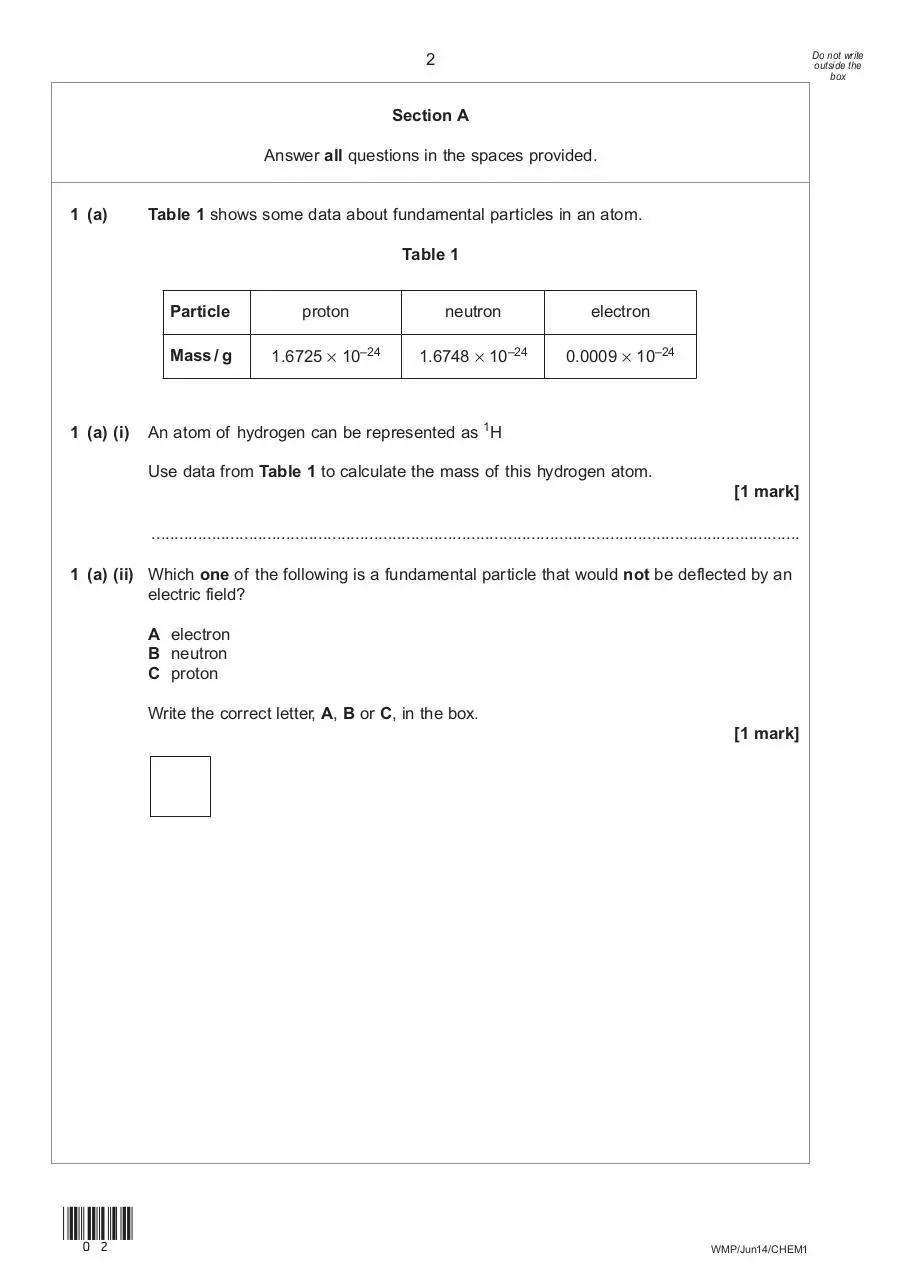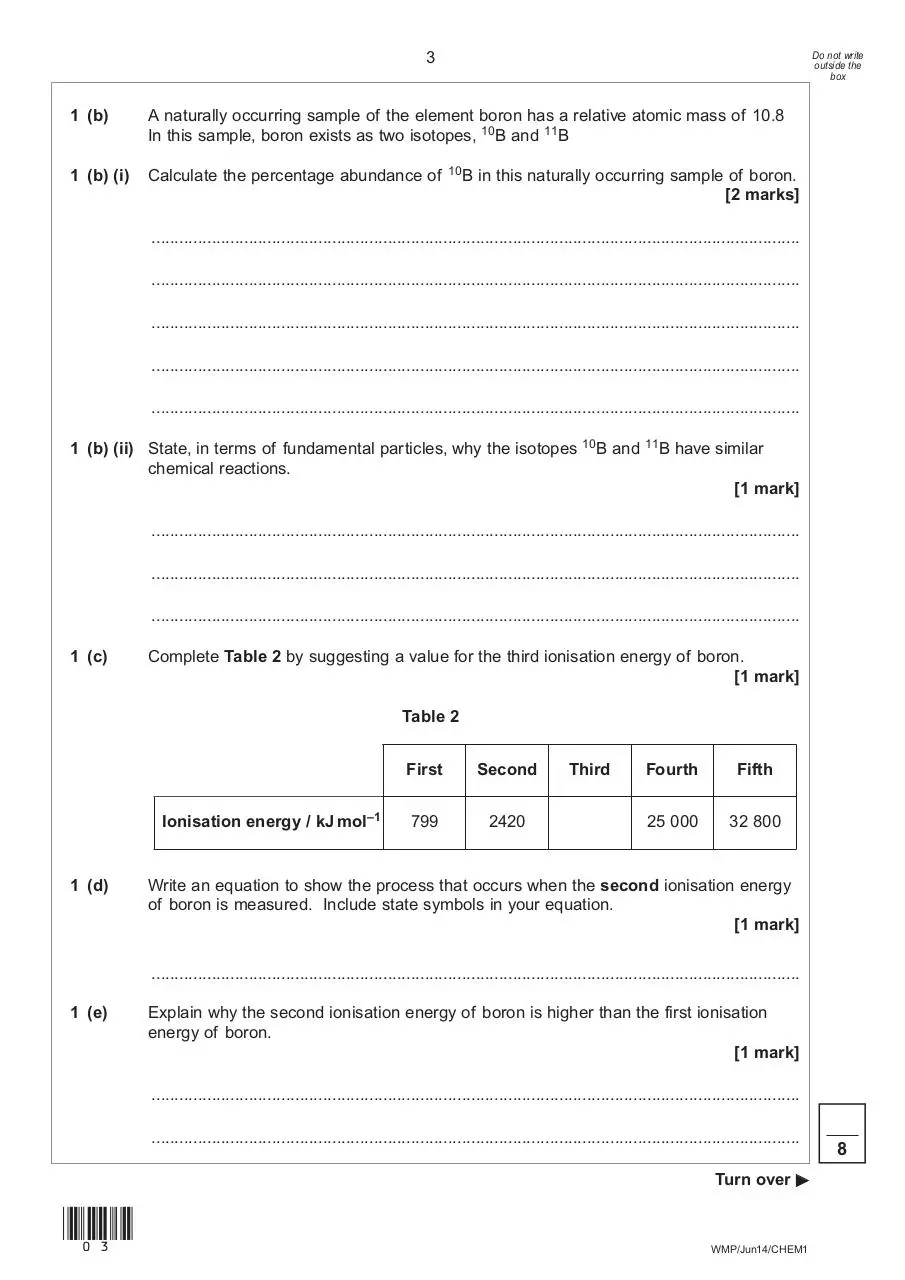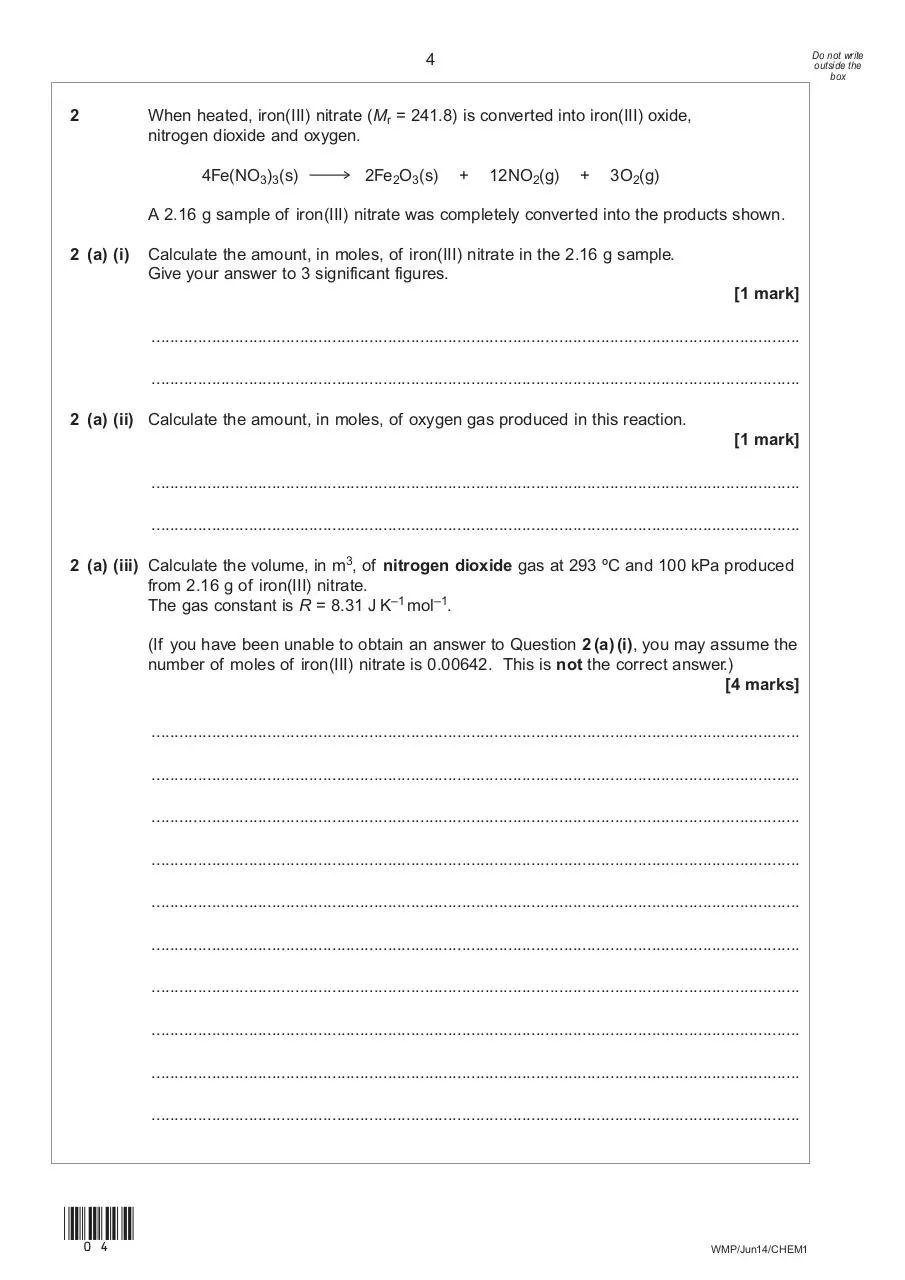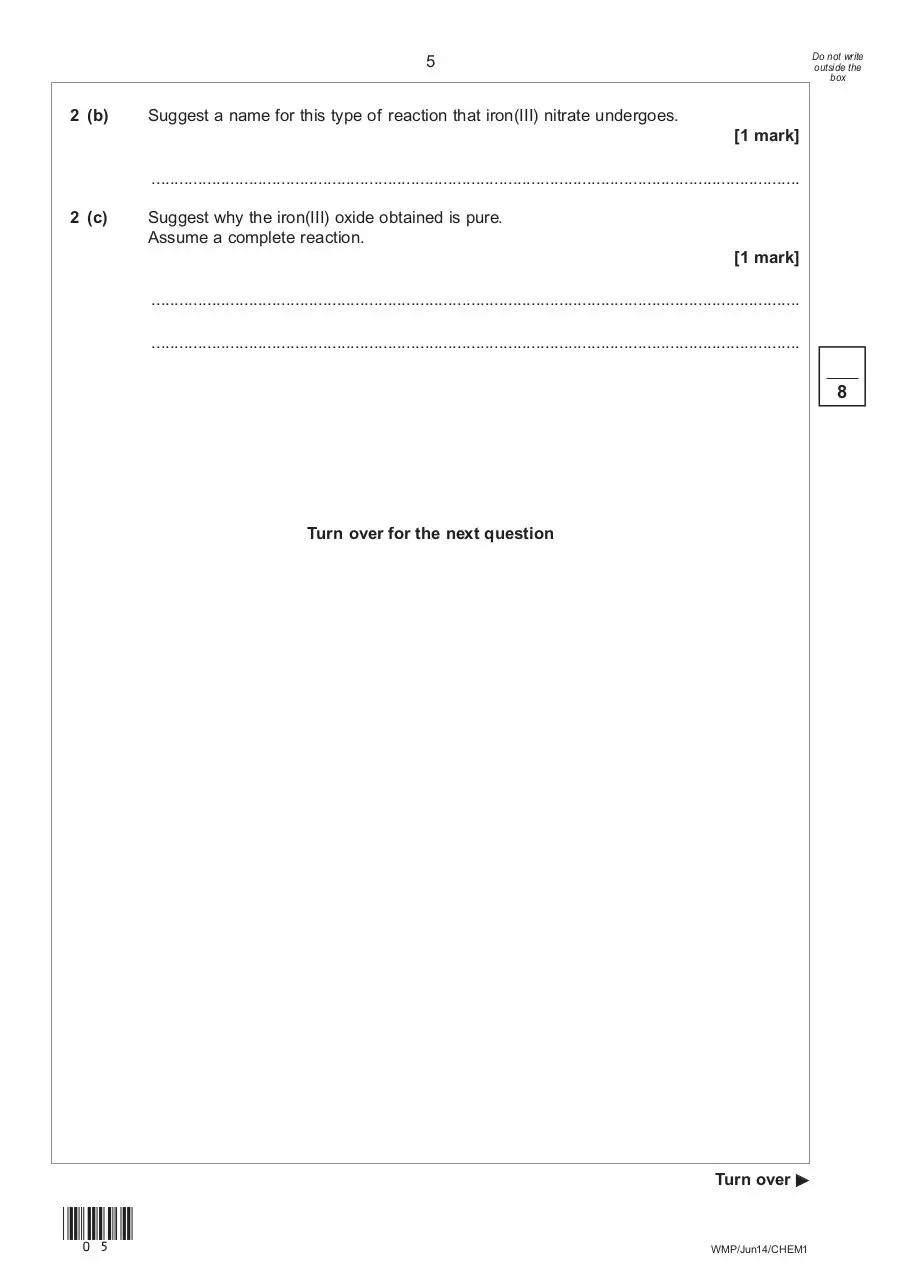AS Jun 14 (PDF)
File information
This PDF 1.6 document has been generated by , and has been sent on pdf-archive.com on 28/02/2017 at 16:02, from IP address 81.108.x.x.
The current document download page has been viewed 559 times.
File size: 1.57 MB (44 pages).
Privacy: public file





File preview
Centre Number
For Examiner’s Use
Candidate Number
Surname
Other Names
Examiner’s Initials
Candidate Signature
Question
General Certificate of Education
Advanced Subsidiary Examination
June 2014
Mark
1
2
3
Chemistry
Unit 1
CHEM1
4
5
Foundation Chemistry
6
Friday 23 May 2014
9.00 am to 10.15 am
7
For this paper you must have:
l the Periodic Table/Data Sheet, provided as an insert
(enclosed)
l a ruler with millimetre measurements
l a calculator.
TOTAL
Time allowed
l 1 hour 15 minutes
Instructions
l Use black ink or black ball-point pen.
l Fill in the boxes at the top of this page.
l Answer all questions.
l You must answer the questions in the spaces provided. Do not write
outside the box around each page or on blank pages.
l All working must be shown.
l Do all rough work in this book. Cross through any work you do not
want to be marked.
Information
l The marks for questions are shown in brackets.
l The maximum mark for this paper is 70.
l You are expected to use a calculator where appropriate.
l The Periodic Table/Data Sheet is provided as an insert.
l Your answers to the questions in Section B should be written in
continuous prose, where appropriate.
l You will be marked on your ability to:
– use good English
– organise information clearly
– use scientific terminology accurately.
Advice
l You are advised to spend about 50 minutes on Section A and about
25 minutes on Section B.
(JUN14CHEM101)
WMP/Jun14/CHEM1/E10w
CHEM1
Do not write
outside the
box
2
Section A
Answer all questions in the spaces provided.
1 (a)
Table 1 shows some data about fundamental particles in an atom.
Table 1
1 (a) (i)
Particle
proton
neutron
electron
Mass / g
1.6725 × 10–24
1.6748 × 10–24
0.0009 × 10–24
An atom of hydrogen can be represented as 1H
Use data from Table 1 to calculate the mass of this hydrogen atom.
[1 mark]
............................................................................................................................................
1 (a) (ii) Which one of the following is a fundamental particle that would not be deflected by an
electric field?
A electron
B neutron
C proton
Write the correct letter, A, B or C, in the box.
[1 mark]
(02)
WMP/Jun14/CHEM1
Do not write
outside the
box
3
1 (b)
A naturally occurring sample of the element boron has a relative atomic mass of 10.8
In this sample, boron exists as two isotopes, 10B and 11B
1 (b) (i)
Calculate the percentage abundance of
10B
in this naturally occurring sample of boron.
[2 marks]
............................................................................................................................................
............................................................................................................................................
............................................................................................................................................
............................................................................................................................................
............................................................................................................................................
1 (b) (ii) State, in terms of fundamental particles, why the isotopes
chemical reactions.
10B
and
11B
have similar
[1 mark]
............................................................................................................................................
............................................................................................................................................
............................................................................................................................................
1 (c)
Complete Table 2 by suggesting a value for the third ionisation energy of boron.
[1 mark]
Table 2
Ionisation energy / kJ mol–1
1 (d)
First
Second
799
2420
Third
Fourth
Fifth
25 000
32 800
Write an equation to show the process that occurs when the second ionisation energy
of boron is measured. Include state symbols in your equation.
[1 mark]
............................................................................................................................................
1 (e)
Explain why the second ionisation energy of boron is higher than the first ionisation
energy of boron.
[1 mark]
............................................................................................................................................
............................................................................................................................................
Turn over
(03)
䊳
WMP/Jun14/CHEM1
8
Do not write
outside the
box
4
2
When heated, iron(III) nitrate (Mr = 241.8) is converted into iron(III) oxide,
nitrogen dioxide and oxygen.
4Fe(NO3)3(s)
2Fe2O3(s)
+
12NO2(g)
+
3O2(g)
A 2.16 g sample of iron(III) nitrate was completely converted into the products shown.
2 (a) (i)
Calculate the amount, in moles, of iron(III) nitrate in the 2.16 g sample.
Give your answer to 3 significant figures.
[1 mark]
............................................................................................................................................
............................................................................................................................................
2 (a) (ii) Calculate the amount, in moles, of oxygen gas produced in this reaction.
[1 mark]
............................................................................................................................................
............................................................................................................................................
2 (a) (iii) Calculate the volume, in m3, of nitrogen dioxide gas at 293 ºC and 100 kPa produced
from 2.16 g of iron(III) nitrate.
The gas constant is R = 8.31 J K–1 mol–1.
(If you have been unable to obtain an answer to Question 2 (a) (i), you may assume the
number of moles of iron(III) nitrate is 0.00642. This is not the correct answer.)
[4 marks]
............................................................................................................................................
............................................................................................................................................
............................................................................................................................................
............................................................................................................................................
............................................................................................................................................
............................................................................................................................................
............................................................................................................................................
............................................................................................................................................
............................................................................................................................................
............................................................................................................................................
(04)
WMP/Jun14/CHEM1
Do not write
outside the
box
5
2 (b)
Suggest a name for this type of reaction that iron(III) nitrate undergoes.
[1 mark]
............................................................................................................................................
2 (c)
Suggest why the iron(III) oxide obtained is pure.
Assume a complete reaction.
[1 mark]
............................................................................................................................................
............................................................................................................................................
8
Turn over for the next question
Turn over
(05)
䊳
WMP/Jun14/CHEM1
Do not write
outside the
box
6
3 (a)
Nickel is a metal with a high melting point.
3 (a) (i)
State the block in the Periodic Table that contains nickel.
[1 mark]
............................................................................................................................................
3 (a) (ii) Explain, in terms of its structure and bonding, why nickel has a high melting point.
[2 marks]
............................................................................................................................................
............................................................................................................................................
............................................................................................................................................
............................................................................................................................................
............................................................................................................................................
3 (a) (iii) Draw a labelled diagram to show the arrangement of particles in a crystal of nickel.
In your answer, include at least six particles of each type.
[2 marks]
3 (a) (iv) Explain why nickel is ductile (can be stretched into wires).
[1 mark]
............................................................................................................................................
............................................................................................................................................
............................................................................................................................................
(06)
WMP/Jun14/CHEM1
Do not write
outside the
box
7
3 (b)
Nickel forms the compound nickel(II) chloride (NiCl2).
3 (b) (i)
Give the full electron configuration of the Ni2+ ion.
[1 mark]
............................................................................................................................................
3 (b) (ii) Balance the following equation to show how anhydrous nickel(II) chloride can be
obtained from the hydrated salt using SOCl2
Identify one substance that could react with both gaseous products.
[2 marks]
......NiCl2.6H2O(s)
+
...... SOCl2(g)
......NiCl2(s)
+
......SO2(g)
+
......HCl(g)
Substance ..........................................................................................................................
9
Turn over for the next question
Turn over
(07)
䊳
WMP/Jun14/CHEM1
Do not write
outside the
box
8
4 (a)
Ammonia gas readily condenses to form a liquid when cooled.
4 (a) (i)
Name the strongest attractive force between two ammonia molecules.
[1 mark]
............................................................................................................................................
4 (a) (ii) Draw a diagram to show how two ammonia molecules interact with each other in the
liquid phase.
Include all partial charges and all lone pairs of electrons in your diagram.
[3 marks]
4 (b)
Ammonia reacts with boron trichloride to form a molecule with the following structure.
Cl
H
H N → B Cl
H
Cl
State how the bond between ammonia and boron trichloride is formed.
[1 mark]
............................................................................................................................................
............................................................................................................................................
............................................................................................................................................
(08)
WMP/Jun14/CHEM1
Do not write
outside the
box
9
4 (c)
Table 3 shows the electronegativity values of some elements.
Table 3
Electronegativity
4 (c) (i)
H
Li
B
C
O
F
2.1
1.0
2.0
2.5
3.5
4.0
Give the meaning of the term electronegativity.
[2 marks]
............................................................................................................................................
............................................................................................................................................
............................................................................................................................................
............................................................................................................................................
4 (c) (ii) Suggest the formula of an ionic compound that is formed by the chemical combination
of two different elements from Table 3.
[1 mark]
............................................................................................................................................
4 (c) (iii) Suggest the formula of the compound that has the least polar bond and is formed by
chemical combination of two of the elements from Table 3.
[1 mark]
............................................................................................................................................
9
Turn over for the next question
Turn over
(09)
䊳
WMP/Jun14/CHEM1
Download AS Jun 14
AS Jun 14.pdf (PDF, 1.57 MB)
Download PDF
Share this file on social networks
Link to this page
Permanent link
Use the permanent link to the download page to share your document on Facebook, Twitter, LinkedIn, or directly with a contact by e-Mail, Messenger, Whatsapp, Line..
Short link
Use the short link to share your document on Twitter or by text message (SMS)
HTML Code
Copy the following HTML code to share your document on a Website or Blog
QR Code to this page

This file has been shared publicly by a user of PDF Archive.
Document ID: 0000561760.